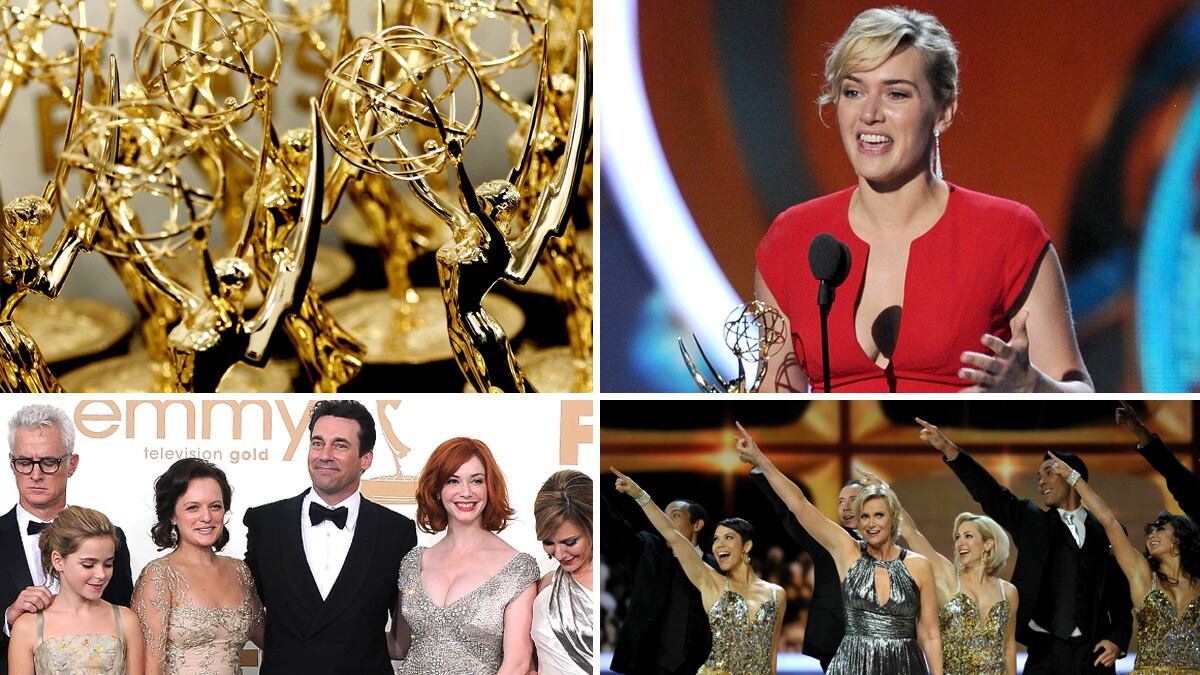In certain parts of Los Angeles, efforts to win over that golden girl, Emmy, are in full force. There are double-decker buses covered in NBC promos riding up and down Hollywood; electronic billboards reminding us of Showtime stars like Michael C. Hall and Claire Danes; newspaper and magazine ads; and lavish DVD mailers for shows all vying for a spot on the Emmy nominations roster next month, and ultimately, a win in September.

The glossy and, at times, extraordinary courtship of the Academy of Television Arts and Sciences’ 15,280 members is a dance that began in earnest in the mid-1990s after Fox and the cable networks became contenders in the race for the TV industry’s most prestigious prize.
How big? Tom O’Neil, who has been tracking Hollywood’s top awards for decades and is the editor of the entertainment awards site GoldDerby.com, estimates that the TV industry spends $30 million to $40 million every year competing for Emmys. That astounding sum covers extravagant advertising campaigns that begin in print but also extend to skywriting over Malibu and Santa Monica beaches and ice-cream trucks delivering free treats at industry haunts.
But there is an aspect of the process that is not as publicized: As the only show business awards show that charges entry, the Emmy Awards are big business for the TV Academy itself. And the exorbitant costs of campaigning also include the fees associated with sending DVD mailers to academy members, making episodes available online on the Academy’s website, and screening shows at the Academy theater.
These charges are unique to the Emmys among the big awards, O’Neil said. “The TV Academy made a business out of it in the mid-90s, when they started charging for entering to offset the costs of the judging process. There’s just too much TV to expect all the voters to have seen it. So the Emmys have set up a system of blue ribbon panels that screen things, vote for things, decide who wins, and it’s a very costly judging system. The question is: are they charging too much?”
The answer is yes, according to those who shell out the big bucks to get their TV shows, stars, and behind-the-scenes players noticed. A dozen executives from broadcast, cable networks, and studios told The Daily Beast that they wonder every year whether it’s worthwhile to spend hundreds of thousands of dollars stumping for Emmys, but they continue to do so because everyone else does. Unlike the Motion Picture Academy, which allows for studios to mail screeners directly to their membership, the TV Academy keeps its list a secret. Networks and studios must pay the Academy $1,500 per episode they want to mail to members and they must also use a designated fulfillment house for shipping their entries.
“These are questions that have been kicking around for a long time,” said one basic cable executive who requested anonymity. “It’s frustrating and it’s troubling, especially when budgets are under great restraint and pressure. In any business, you want to look for efficiencies and ways to have the same type of service at the most efficient price point that you can. And, unfortunately, this doesn’t allow for that option.”
Typically, networks and studios send one or two episodes of their dramas and comedies for consideration. But in some instances, the cable networks, especially, opt to send full seasons of their series. For HBO, for example, to mail the entire season, or 10 episodes, of Game of Thrones, the premium cable network must pay the Academy $15,000—a fee that does not cover the design or production of the DVD mailer or shipping. One cable executive said he calculated that this year he would have saved $5.25 per package if he were allowed to use his own shipping vendor.
“If you don’t do the mailers, you’d be making a mistake, and if you did do them, it might not have any impact whatsoever,” said a network executive who asked to remain anonymous. “I’ve got to believe this is a pretty significant source of income for the Academy. I just know that as long as this policy continues to be in place, we and every other network will continue to do the same thing because the costs associated with doing nothing are incalculable. We’re all in the talent relations business and this is about getting new talent to come to you.”
While the Academy understands why executives would prefer to use their own shipping companies, confidentiality is of utmost importance, said John Leverence, the Academy’s senior vice president of awards. “We have made it exclusive for a single company to do the mailing because in all the years we have been doing this, we’ve never had a single breach in confidentiality and that’s a pledge we make to our members. The fact of the matter is the fulfillment house charges whatever the postal rate is and a small handling fee. It’s not a situation where the Academy is attempting to make a significant profit of all this.”
HBO, which led the awards promotional charge in the ‘90s as it sought to be taken as seriously as the broadcast networks, might be able to afford the costly rates. But network and studio marketers say the process is unfair to the smaller cable networks that can’t dole out hundreds of thousands of dollars to promote just one TV show during awards season. Which is why a scrappy cable outfit, like the Food Network, might choose to prioritize awards season over other publicity and spend the money on packaging their Emmy mailers in lunch pails. It proved to be the season’s most noticeable package, but will it earn nominations?
“The Academy wants to emphasize what’s really important here is what’s on the DVD,” Leverence said.
“This is a situation where everybody needs to keep their priorities straight. The Emmy Awards are all about excellence, about industry professionals evaluating the work itself. Of course, it’s the marketer’s instinct to cut through the clutter and package something in a way that might catch your eye. But at the end of the day, let’s face it: if it’s not on the DVD, it’s not going anywhere.”
To offset the costs and “democratize” the process, especially for those at a disadvantage, the academy has been allowing networks and studios to post episodes on the academy site for a couple of years, Leverence said. But that’s not free either. To post one episode costs $175.
“I don’t think any of this necessarily works,” said another basic cable executive who did not want to be named. “There’s some value to getting a name out there. It’s name recognition on a ballot. But for a small network, it’s hard to compete. We all spend this money because we’ve been told to do it. It’s just how things have been done forever. Some people have tried to go about it different ways. We’ve all talked about not doing these hard copy mailers but everybody still does them. I’m sure if I put in blank discs in my mailer, nobody would even call me and say they were blank.”
Because the entire membership can vote on all of the programming categories, most networks and studios spend the money on sending mailers to everyone instead of specialized peer groups. But Leverence says the Academy does not keep track of the voting and does not see the ballots after they’ve been tabulated, so it’s impossible for those competing to know if they’re targeting the right people. “The fact is if you don’t know how many people are voting and which people are voting, it’s a shot in the dark,” said one network executive.
“Most people vote for their favorites and for the shows they’ve worked on,” added a cable executive.
“They don’t watch everything in a category. There are many shows out there that are deserving of winning and are never going to get nominated—no matter how much money the network or studio puts into it.”
Still, a nomination or a win does increase the public and industry profile of a TV show and its actors, and that makes the costly process worthwhile, said Richard Licata, NBC’s executive vice president of communications, who is trying to revamp that network’s image by plastering buses with ads and offering Emmy voters the first iPad app for downloads.
“The hat trick for those of us who participate is to figure out ways to get our messages out in an innovative, creative, economical, and ecological way,” Licata said. “It’s a process that’s evolving as fast and furious as the TV industry itself. In the past 20 years, we’ve moved from placing our programs in retail rental stories for Academy members to check out to VHS mailers to DVDs to online streaming and ultimately to mobile applications.”
The nominations process ended Thursday afternoon, and selections will be announced on July 19. Those who make the cut might be glad they spent the money; the rest probably won’t.
“It is big business and it’s odd to think that Hollywood would spend more than $30 million a year to win a fake gold statuette that costs $400 to manufacture,” O’Neil said. “But it’s a place in the history books, the approval of your peers. It’s a pat on the back they crave.”






